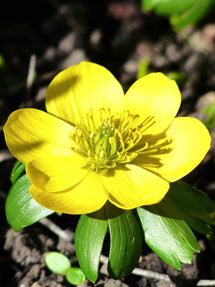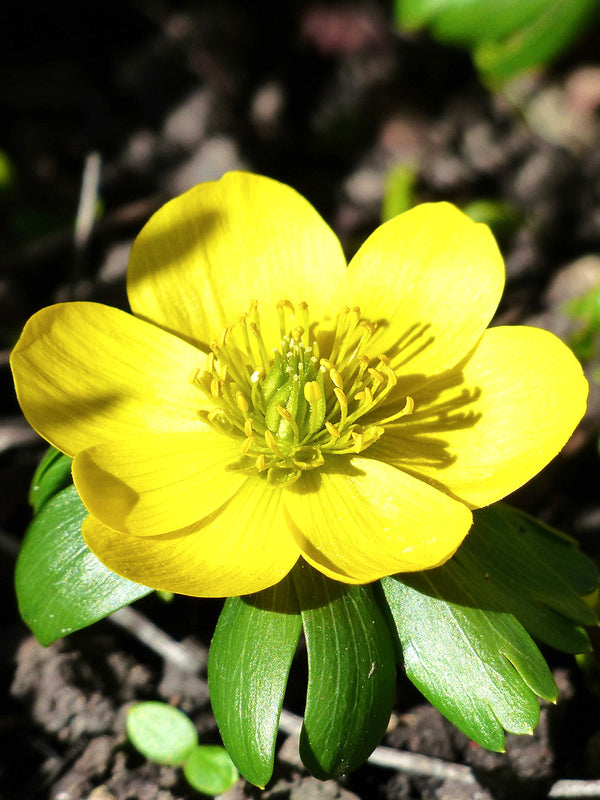Eranthis (Winter Aconite)
Few sights are more uplifting than the golden glow of Winter Aconite (Eranthis). This plant is one of the earliest flowers to bloom, often pushing through frozen soil while snow still lingers. Winter Aconite brings bright yellow flowers to dormant garden spaces, signaling the end of the winter. Gardeners value its dependable return each spring and its ability to naturalize, forming larger displays over time.
Showing 1 - 1 in 1 items
Winter Aconite, is one of the earliest Spring bulbs
Eranthis Hyemalis: An Award-Winning Hardy Perennial
The genus Eranthis belongs to the buttercup family (Ranunculaceae). There are eight species in this genus, the most common of which is Eranthis “Hyemalis”, sometimes called “Bulb Me Up Buttercup” or “Winter Wolf's Bane”. What makes Eranthis special is its unique behavior. Its flowers open only when the sun shines and close during periods of darkness. When planted in groups, its cup-shaped yellow blooms, surrounded by a collar of fresh green leaves, create a glowing carpet. Celebrated by gardeners for generations, Eranthis “Hyemalis” has earned the prestigious Award of Garden Merit from the Royal Horticultural Society, a testament to its beauty, reliability, and horticultural value.
Another aspect that makes Winter Aconite special is that it can grow in a variety of growing conditions. It thrives in lightly shaded areas, particularly under deciduous trees and shrubs, bringing brightness to these darker spots. It reliably performs in USDA zones 4 through 9, making it a favorite among gardeners across much of the United States. Whether you're working with a rock garden, woodland edge or a formal flower bed, Eranthis “Hyemalis” adapts easily and rewards you with consistent, cheerful blooms each year.
Rediscovering Eranthis: A Small Plant With A Big Impact
Eranthis “Hyemalis” tends to be one of the forgotten bulbs, but at DutchGrown, we believe it’s time to change that by offering this charming early bloomer in our collection. Other varieties, such as Eranthis “Cilicica” with slightly larger flowers and finely divided foliage, are less common in cultivation.
With its low-growing habit of just 4 inches, Hyemalis is perfectly suited for rock gardens, woodland gardens, and mixed flower beds. It pairs well with other early bloomers, such as Snowdrops or Crocuses, creating soft carpets of color and texture. Loved by pollinators and naturally deer-resistant, Winter Aconite brings both beauty and resilience to the early spring garden. Once established, it reliably returns every year, quietly transforming dull winter spaces into cheerful, living borders. It’s a small bulb that makes a big impression.
Read more: Everything You Need To Know About Winter Aconites (Eranthis Hyemalis)
How To Plant Winter Aconite For Maximum Effect In Your Garden
Planting Winter Aconite is simple, and with the right care, it will reward you with years of early spring beauty. Follow the steps below to grow Winter Aconite easily.
Start by choosing a spot in your garden with well-drained, humus-rich soil that receives full sun or partial shade. Good options are under deciduous trees or shrubs. Wait until the soil temperature drops below 60°F. In northern regions, the best time to plant is in early fall (September or October). In warmer regions, mid-to-late fall (October or November) is the ideal time. Soak the tubers overnight before planting to help them establish. Plant each bulb 2–3 inches deep and 3–4 inches apart, with the pointy ends facing up. Water once after planting, then let nature take its course. Once the flowers have faded, allow the foliage to remain until the entire plant naturally yellows and withers. This helps the bulbs store energy for next year.
Although it may be tempting to grow Eranthis bulbs in pots, they will not thrive. They prefer to remain undisturbed in the ground, so it’s best to plant Winter Aconite in the full ground. Do you want to learn more? Follow our growing guide “How to Grow Eranthis - Winter Aconite?”.
Buy Winter Aconite Bulbs At DutchGrown
Would you like to brighten up your early-flowering garden? Winter Aconite is an excellent choice. At DutchGrown, you'll find top-sized, true Eranthis “Hyemalis” bulbs that are carefully selected for their strength, reliability, and long-lasting performance. When you buy from us, you're not just planting flowers; you’re joining a tradition built on knowledge, quality, and care. Let us help you bring early spring to life with Winter Aconite. We ship throughout the US.
Frequently Asked Questions About Winter Aconite
Is Eranthis Hyemalis Invasive?
Although Ertanthis “Hyemalis” is not officially classified as invasive, it spreads easily under favorable conditions. Once it is established, it can naturalize and form large colonies over time, especially in undisturbed garden beds or wooded areas.
Where Is The Best Place To Plant Winter Aconites?
The best place to plant Winter Aconites is in well-drained soil and partial shade to full sun. Under deciduous trees or shrubs, such as roses, is an ideal location. These areas provide the right balance of sunlight in late winter and early spring. Eranthis “Hyemalis” grows best in USDA hardiness zones 4 to 9 and will reliably return each year when left undisturbed in a cool, shaded, and natural garden setting.
Do Winter Aconites Like Sun Or Shade?
Winter Aconites like full sun to partial shade, especially during their blooming period in late winter and early spring. They thrive in areas that receive sunlight before trees and shrubs leaf out. Once they have finished blooming, they tolerate shade well. Planting them under deciduous trees is ideal, because it provides early sunlight followed by protective shade, which helps the bulbs naturalize and return year after year.
How Do You Plant Eranthis Hyemalis Bulbs?
Plant Eranthis “Hyemalis” in well-drained, humus-rich soil in full sun or partial shade during the fall. Soak the tubers overnight and plant the flower bulbs 2–3 inches deep and 3–4 inches apart the following day. Water them once after planting, then allow nature to take over. Allow the foliage to yellow naturally after flowering to store energy for next year's vibrant display.

